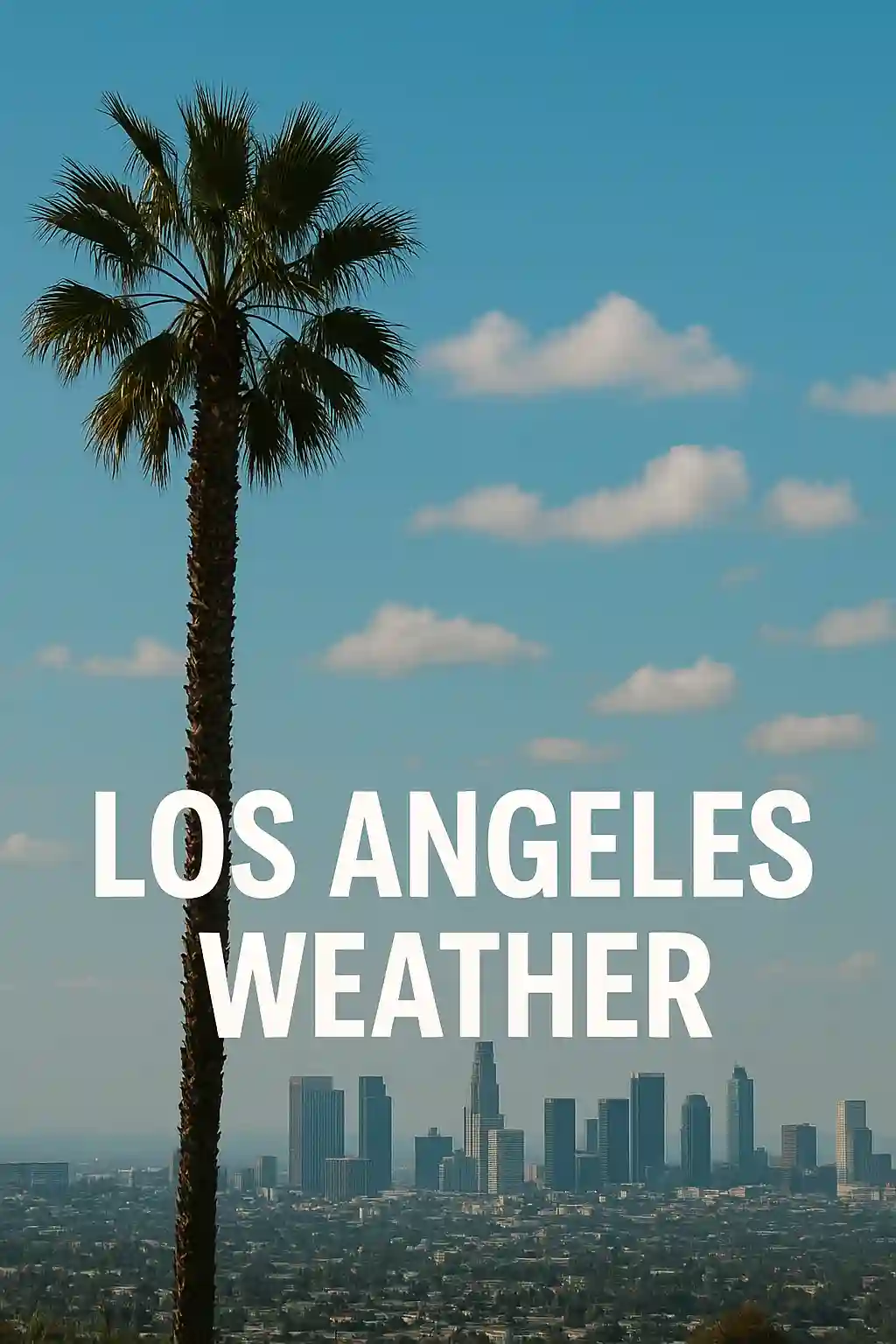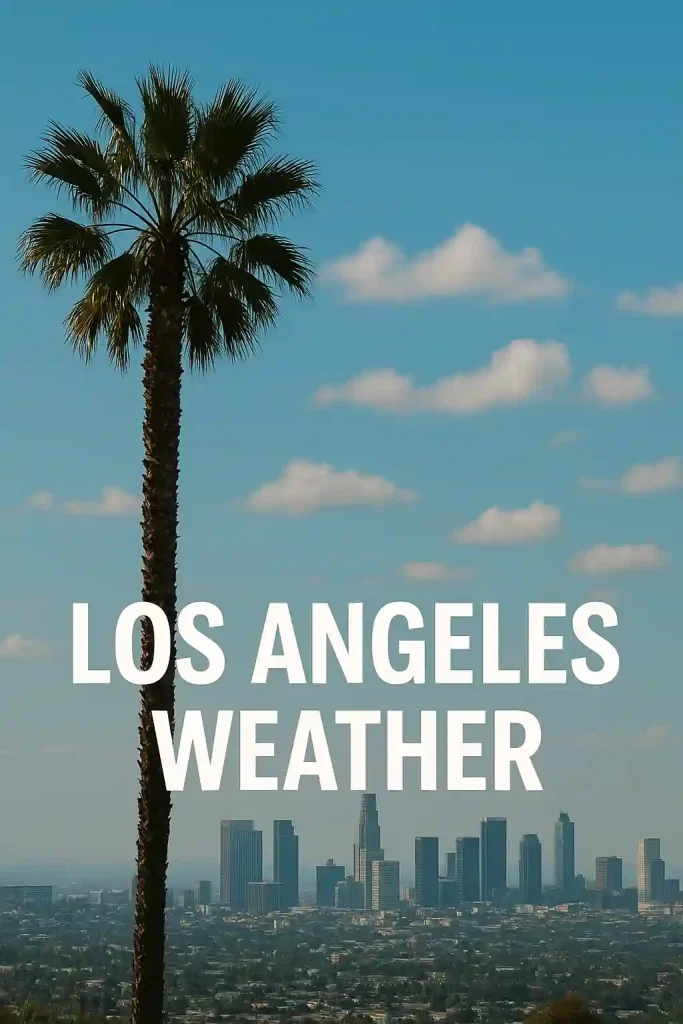Los Angeles Weather: A Complete Guide for Visitors and Locals

Los Angeles Weather
Table of Contents
Los Angeles, California—famously known as the “City of Angels”—isn’t just the global hub of entertainment and lifestyle; it’s also one of the most weather-friendly cities in the world. With over 280 days of sunshine annually, LA attracts millions of tourists, dreamers, and residents who long for the perfect balance of warmth and ocean breezes.
In this in-depth weather guide for Los Angeles, we’ll cover everything: average temperatures by season, rainfall patterns, climate zones across LA County, best times to visit, climate change effects, travel tips, and more. Whether you’re a traveler planning your first trip or a local wanting detailed insights, this article has everything you need.
Quick Facts About Los Angeles Weather
- Climate Type: Mediterranean climate (Köppen: Csa).
- Average Yearly Sunshine: 280–300 days.
- Annual Rainfall: About 15 inches (mostly in winter).
- Average Temperatures:
- Summer: 75°F–90°F (24°C–32°C).
- Winter: 48°F–68°F (9°C–20°C).
- Humidity: Generally low, but varies near the coast.
- Microclimates: Beaches, valleys, and mountains each have different weather.
Los Angeles Weather by Season
1. Spring in Los Angeles (March – May)
Spring in LA is beautiful, with warm days and cool nights.
- Average Temperatures: 60°F–75°F (15°C–24°C).
- Rain: Light showers possible in March, but mostly dry by May.
- What to Expect: Wildflowers in bloom, green hills, and clear skies.
Best Activities: Hiking in Griffith Park, exploring Malibu, attending outdoor festivals.
2. Summer in Los Angeles (June – August)
Summer is the peak tourist season. Beaches are crowded, and the Hollywood Bowl concerts light up the nights.
- Average Temperatures: 75°F–90°F (24°C–32°C).
- Heat Waves: Occasionally temperatures spike over 100°F (38°C), especially in inland valleys.
- Humidity: Low, but wildfire season risks increase.
Best Activities: Surfing in Venice Beach, Disneyland trips, rooftop bars.
3. Fall in Los Angeles (September – November)
Fall brings slightly cooler temperatures but plenty of sunshine.
- Average Temperatures: 65°F–85°F (18°C–29°C).
- Santa Ana Winds: Strong, dry winds that can cause wildfires.
- What to Expect: Clear skies, stunning sunsets, fewer crowds.
Best Activities: Wine tasting in Malibu, attending film festivals, hiking Runyon Canyon.
4. Winter in Los Angeles (December – February)
Winter in LA is mild compared to most U.S. cities.
- Average Temperatures: 48°F–68°F (9°C–20°C).
- Rainfall: Most of the yearly rain occurs in these months.
- Snow: Rare in the city but common in nearby mountains.
Best Activities: Ski trips to Big Bear, exploring museums, cozy nights in Downtown LA.
Los Angeles Microclimates
One fascinating feature of LA weather is its microclimates. Within a short drive, you can go from a chilly coastal breeze to hot desert-like heat.
- Beaches (Santa Monica, Venice, Malibu): Cooler, foggy mornings (“June Gloom”).
- Downtown LA: Warmer, with less fog.
- San Fernando Valley: Hotter summers, often above 100°F.
- Mountains (Big Bear, Angeles National Forest): Cold winters, snow in higher elevations.
This variety makes LA unique—locals often joke you can surf in the morning and ski in the afternoon.
Rainfall Patterns in Los Angeles
Los Angeles is generally dry, but when it rains, it pours.
- Rainy Season: December to March.
- Driest Months: May through September.
- Annual Rainfall: ~15 inches.
- El Niño & La Niña: These Pacific weather patterns can cause extreme rainfall or droughts.

Wildfires and Santa Ana Winds
Los Angeles is beautiful but vulnerable to wildfires, especially in late summer and fall.
- Cause: Dry vegetation, heat waves, strong winds.
- Santa Ana Winds: Can spread fires rapidly.
- Safety Tips: Always check fire danger alerts if visiting rural areas.
The Coastal Influence
The Pacific Ocean regulates much of LA’s weather.
- Coastal areas are cooler and experience fog.
- Inland valleys heat up significantly.
- “June Gloom” is common—overcast mornings that burn off by noon.
Best Time to Visit Los Angeles
- Best Overall: Spring (March–May) and Fall (September–November).
- For Beaches: Summer (June–August).
- For Budget Travel: Winter (December–February, except holidays).
Travel Tips for Los Angeles Weather
- Pack Layers: Temperature shifts quickly between day and night.
- Use Sunscreen: Even in winter, the sun is strong.
- Bring Sunglasses & Hat: Essential for year-round protection.
- Check Microclimates: Weather in Malibu differs from Pasadena.
- Stay Hydrated: Especially in hot summer months.
Climate Change and Los Angeles Weather
Los Angeles is experiencing noticeable climate shifts:
- Hotter Summers: More frequent heatwaves.
- Droughts: Water shortages and restrictions.
- Increased Wildfires: Longer fire seasons.
- Rising Sea Levels: Affecting coastal neighborhoods.
Los Angeles Weather by Neighborhood
- Santa Monica & Venice: Cooler, foggy mornings, great beach weather.
- Downtown LA: Warmer, less fog, vibrant nightlife.
- Hollywood & Beverly Hills: Mild, sunny, perfect for outdoor attractions.
- Pasadena & San Fernando Valley: Much hotter in summer.
- Long Beach: Mild coastal temperatures, breezy.
Frequently Asked Questions About Los Angeles Weather
Does it ever snow in Los Angeles?
Snow is extremely rare in the city itself, but nearby mountains like Big Bear and Mt. Baldy get plenty of snow in winter.
Is Los Angeles always sunny?
Not always—winter brings rain, and June Gloom brings cloudy mornings. But sunshine is dominant year-round.
What is the hottest month in Los Angeles?
August and September are usually the hottest months, especially inland.
Can you swim in Los Angeles beaches year-round?
Yes, but ocean water is cooler than expected (55°F–70°F). Many locals wear wetsuits.
Is Los Angeles weather good for allergies?
LA has pollen seasons (spring and fall), but ocean breezes help reduce air pollution.
Final Thoughts
Los Angeles weather is one of the city’s greatest assets. With its mild winters, sunny summers, and diverse microclimates, LA offers something for everyone. Whether you’re hitting the beaches, exploring Hollywood, hiking in the mountains, or just enjoying the sunsets, the City of Angels provides an almost perfect year-round climate.
If you’re planning a trip, remember: pack layers, expect sunshine, and don’t forget sunscreen.
Ashley Biden: Championing Equity, Mental Health & Community from the First Daughter’s Platform



